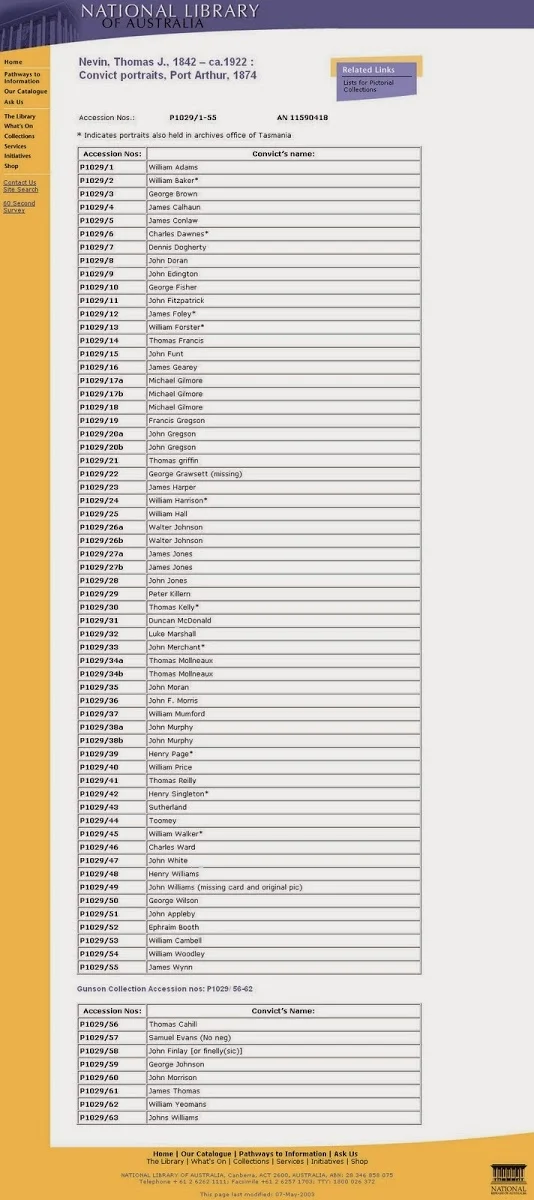CLIFFORD & NEVIN, photographers 1860s-1880s
Hand-colouring
Professional photographers Thomas J. Nevin (1842-1923) and Samuel Clifford (1827-1890) were close friends and colleagues over a period dating from ca. 1865 to Clifford's death in 1890. Both maintained photographic studios in Hobart, producing commercial stereographs in significant numbers, as well as providing the local population with studio portraits. This full length carte-de-visite portrait of a young man standing next to a kitchen chair is heavily tinted. The verso bears the handwritten inscription "Clifford and Nevin, Hobart Town". Several portraits with similar heavy colouring and the verso inscription, written in Clifford's hand, are held in private and public collections.


Full-length cdv of young man, heavily tinted with violet, bright red and dark red.
Verso inscribed "Clifford & Nevin Hobart Town"
Courtesy © The Private Collection of John & Robyn McCullagh 2006 ARR.
The colouring in this carte and others with similar provenance (northern Tasmania and Victoria) is sometimes mistakenly assumed to be the work of the studio colourist, which was not the case (McPhee QVMAG, 2007). The colouring was applied after the purchase of the print by a family member, probably by a child playing with a small hand-held stereoscopic viewer.
"Clifford & Nevin, Hobart Town"
Photo historians have assumed the relationship with Samuel Clifford was transitory, not lasting longer than ca 1870 (McPhee, QVMAG 2007), which was not the case. They have also assumed that Clifford ceased commercial practice ca. 1873 (Kerr, 1992, Long, 1995), which also appears to be incorrect. When Thomas J. Nevin advertised his retirement from commercial practice in the Mercury, 17th January 1875, on the eve of his appointment to civil service as Office and Hall Keeper for the Hobart City Council at the Hobart Town Hall, Samuel Clifford announced in the same advertisement that he had acquired T. J. Nevin's commercial negatives taken for private clients and would reprint them on request:
TRANSCRIPT
PHOTOGRAPHY:- T.J. NEVIN, in retiring from the above, begs to thank his patrons for the support he has so long received from them, and also to state that his interest in all the Negatives he has taken has been transferred to Mr S. CLIFFORD, of Liverpool-street, to whom future applications may be made. In reference to the above, Mr T.J. Nevin's friends may depend that I will endeavour to satisfy them with any prints they may require from his negatives. S. CLIFFORD.Source: Mercury, 17th January, 1876
Samuel Clifford had not ceased practice in 1873, therefore, as most commentators have assumed, and many extant prints with Samuel Clifford's stamp or attribution are likely to be later reprints from Thomas Nevin's negatives, including Nevin's stereographs of Port Arthur (1872-1874), and of the upper Derwent Valley (late 1860s-1874). Samuel Clifford inserted another notice in the Mercury of 16th March 1878 to advertise the sale of his own photographic stock:
Tasmanian Index (Newspapers & Journals) Title: [Sale of Samuel Clifford's photographic stock] In: Mercury 16/03/1878 Page(s): 2, column 3 Notes: Transcribed from Stilwell Index (Allport Library and Museum of Fine Arts) Sale of his photographic stock in trade, camera, lenses, printing frames etc., Liverpool Street. Subjects: Clifford, Samuel, 1827-1890.Source: the Stilwell Index, State Library of Tasmania
When Samuel Clifford sold his photographic stock to commercial photographers Joshua and Henry Anson in 1878, these two brothers reprinted Clifford's negatives, among which were negatives by Nevin that Clifford had acquired in 1876. Those same negatives were reprinted again when John Watt Beattie joined the Anson brothers at their studio at Wellington Bridge in Elizabeth Street, Hobart in 1892. Beattie in turn reprinted the work of all four of these earlier photographers, often failing to attribute their work or accredit them by name.
RELATED POSTS main weblog

